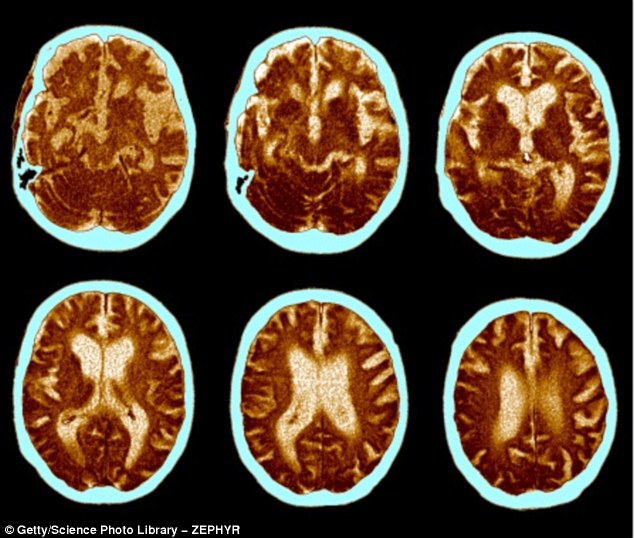Editor’s NOTE: Although the use of Cannabis, Cannabis Oil, nor the smoking of Marijuana was never a part of the Kelley Protocols for disease treatment, he would have been among the first to admit that nature DOES provide natural healing entities for optimum health. ~ Ed.
Drug’s active ingredient ‘helps remove key toxic protein from brain cells’

A number of compounds found in cannabis could prove effective as a treatment for Alzheimer’s disease, experts suggest.
Early findings show tetrahydrocannabinol (THC) – the key mind-altering element of the drug – promote the removal of amyloid beta from the brain.
The toxic protein is the main component of plaques that form in the brain – widely considered a signature of the disease, and as such its presence and build-up is indicative of the most common form of dementia.
Furthermore, the new research has offered insight into the role inflammation plays in triggering Alzheimer’s.
And experts at the Salk Institute in California, said they hope the discovery will provide clues to developing new therapies to treat the condition.

The main active ingredient in cannabis, tetrahydrocannabinoid (THC) could form the basis of new treatments for Alzheimer’s, scientists at the Salk Institute believe
Professor David Schubert, senior author of the paper, said: ‘Although other studies have offered evidence that cannabinoids might be neuroprotective against the symptoms of Alzheimer’s, we believe our study is the first to demonstrate that cannabinoids affect both inflammation and amyloid beta accumulation in nerve cells.’
Alzheimer’s is the most common form of dementia, and is a progressive brain disorder that leads to memory loss.
The disorder can have a catastrophic impact on a patient’s life, seriously impairing their ability to carry out previously simple, daily tasks.
More than five million Americans are battling the condition, according to the National Institutes of Health, and it is a leading cause of death.
In the UK, the charity Alzheimer’s Research UK estimates 850,000 people are living with the disorder – but note by 2025 that number is expected to reach one million, rising to two million by 2050.
Scientists have long known that amyloid beta accumulates in the nerve cells of the aging brain, well before the appearance of Alzheimer’s symptoms and the telltale plaques.
“Although other studies have offered evidence that cannabinoids might be neuroprotective against the symptoms of Alzheimer’s, we believe our study is the first to demonstrate that cannabinoids affect both inflammation and amyloid beta accumulation in nerve cells.” ~ Professor David Schubert, Salk Institute
Amyloid beta is a major component of the plaque deposits that are a hallmark of the disease.
The presence of plaques on the brain, is an indication that can lead to a diagnosis of Alzheimer’s.
However, the precise role of amyloid beta and the plaques it forms in the disease process still evades scientists.
Exploring the subject, Salk researchers studied nerve cells that had been altered to produce high levels of amyloid beta, to mimic aspects of Alzheimer’s disease.
They found that high levels of amyloid beta were linked to inflammation within cells, and subsequent higher rates of neuron – a type of cell – death.
The team were able to demonstrate that exposing the cells to THC reduced amyloid beta protein levels and eliminated the inflammation from the nerve cells, which was caused by the protein.
As a result they were able to show that THC helped allow the nerve cells to survive.
Antonio Currais, a postdoctoral researcher, and first author of the paper, said: ‘Inflammation within the brain is a major component of the damage associated with Alzheimer’s disease, but it has always been assumed that this response was coming from immune-like cells in the brain, not the nerve cells themselves.
‘When we were able to identify the molecular basis of the inflammatory response to amyloid beta, it became clear that the THC-like compounds that the nerve cells make themselves may be involved in protecting the cells from dying.‘
Brain cells have switches known as receptors that can be activated by endocannabinoids, a class of lipid molecules made by the body that are used for signalling between cells in the brain.

The precise role of amyloid beta and the plaques it forms in the disease process still evades scientists. However, the team were able to demonstrate that exposing the cells to THC reduced amyloid beta protein levels and eliminated the inflammation from the nerve cells, which was caused by the protein
The psychoactive effects of marijuana are caused by THC, a molecule similar in activity to endocannabinoids that can activate the same receptors.
Physical activity results in the production of endocannabinoids and some studies have shown that exercise may slow the progression of Alzheimer’s disease.
Professor Schubert emphasized that his team’s findings were conducted in exploratory laboratory models, and that the use of THC-like compounds as a therapy would need to be tested in clinical trials.
In separate but related research, his lab found an Alzheimer’s drug candidate called J147 that also removes amyloid beta from nerve cells and reduces the inflammatory response in both nerve cells and the brain. It was the study of J147 that led the scientists to discover that endocannabinoids are involved in the removal of amyloid beta and the reduction of inflammation.
The study, which was supported by the National Institutes of Health, The Burns Foundation and The Bundy Foundation, are published in the journal Aging and Mechanisms of Disease.
Related Story: Scientists use YEAST to brew THC: Chemical usually found in cannabis could lead to better HIV and cancer drugs
Written by Lizzie Parry and published by The Daily Mail ~ June 29, 2016.
FAIR USE NOTICE: This site contains copyrighted material the use of which has not always been specifically authorized by the copyright owner. We are making such material available in our efforts to advance understanding of environmental, political, human rights, economic, democracy, scientific, and social justice issues, etc. We believe this constitutes a ‘fair use’ of any such copyrighted material as provided for in section 107 of the US Copyright Law. In accordance with Title 17 U. S. C. Section 107, the material on this site is distributed without profit to those who have expressed a prior interest in receiving the included information for research and educational purposes. For more information go to: http://www.law.cornell.edu/uscode/17/107.shtml“
